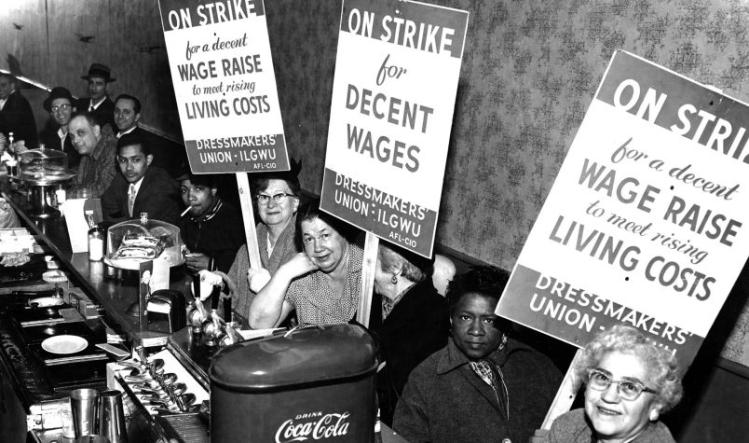
Toward the beginning of his new book, Thomas Geoghegan tells of a dispiriting conversation he had with a friend who works at a Ford assembly plant in Chicago. As part of the plant’s two-tier pay scale, new workers begin at $14 an hour, half the rate of many of its experienced workers. Not only that, new hires receive no health insurance during their first nine months, and do not join the pension plan for thirty-six months, “and even then it’s just a 401(k).”
“You see,” Geoghegan’s friend says of America’s manufacturers, “they don’t have to move to the South now to get $14 an hour. They can get it right here.” Yes, even in Chicago, that long-time bastion of labor might. “We’re all Southerners now,” Geoghegan writes with sarcasm and regret.
In his brightly written book, Only One Thing Can Save Us: Why America Needs a New Kind of Labor Movement (The New Press), Geoghegan—a longtime labor lawyer in Chicago—lays out many of the depressing ways that American workers have been moving backward. He describes “the little, old white-haired” Starbucks barista who has to continue working into her “golden years” to make ends meet. Then there’s the road dispatcher, “the guys who come out and jump your car” if you break down and you’re in an auto club. They used to be employees, but now they’re independent contractors, and after they pay for gas and leasing their truck, they barely make the minimum wage.
“It’s eerie to think that in the famous Great Depression play, Waiting for Lefty by Clifford Odets, those cabdrivers who went on strike had more rights than many of us do today,” Geoghegan writes. “At least in those days, unlike now, the cabdrivers still worked for actual employers; at least, unlike now, they could count on getting Social Security”—something that millions of workers who have been pushed, often fraudulently, into the independent-contractor box can no longer count on. In his let-me-count-the-ways-we’ve-moved-backward section, Geoghegan notes that in 1992, the richest 10 percent of Americans had twenty times as much wealth as the bottom 50 percent. By 2010, it was sixty-five times.
For Geoghegan, the overriding issue facing the nation is the decades-long slide in the wages, benefits, and treatment of American workers. And to his mind, by far the best solution to address—and redress—this problem is to rebuild the nation’s languishing labor movement.
In the book’s very first paragraph, he notes that he’s often asked, “So, do you think ‘labor’ will ever come back?” His response (with a kick of the can down the road): The problem is not just bringing back labor, but bringing back the middle class.
A French venture capitalist tells the author that he sees two big differences between the United States and France. The first is the United States is much more open—it’s easier to make contacts and start businesses, while the second is “there’s no middle class.” Geoghegan explains that middle-class workers, like clerks and construction laborers, have taken pay cuts and now start at $40,000 a year, putting their families in the “near poor” category. (I saw a recent study showing that the median wage for construction workers in Texas was just $10 to $11 an hour, around $21,000 a year—notwithstanding the industry’s high fatality rate in Texas.)
A fluid writer, Geoghegan devotes the bulk of his engaging book to that famous question: What is to be done? He asks this at a time when unions seem to be going backward rather than forward in strength and numbers.
Geoghegan bemoans the enactment of recent laws that eviscerate the power of public-sector unions (Wisconsin) and sap union treasuries (“right to work laws” in Indiana, Michigan, and Wisconsin). He writes, “Our current American labor law model has been quite good at holding down unions, but conservatives can’t seem to leave it alone.” In other words, conservatives are all too happy to kick labor when it’s down.
Geoghegan has various smart (and perhaps wishful) prescriptions for how labor might right its listing ship. He warns that traditional strikes—for instance, eight hundred workers at a tire plant walking out, with little public support and media attention—are not a recipe for success. It’s too easy for companies to win by using replacement workers, relying on other factories, and waiting out the strikers. Rather, Geoghegan argues, any union that hopes to emerge victorious from a strike needs to make sure its walkout is a very visible affair for which the union has lined up strong public support. That maximizes the chances of success and often helps show that unions are fighting not just for their members, but for a larger cause.
Geoghegan gives an A-plus to the Chicago Teachers Union’s 2012 strike, holding it out as a model. That much-publicized walkout had overwhelming support from not just the 26,000 teachers, but also the parents of the 320,000 schoolchildren. The teachers were demanding smaller class sizes, and some held picket signs, saying, “Honk, if you want more arts education.” And honk many drivers did. The union’s march on City Hall drew thousands of raucous supporters and mega-media coverage. The teachers had such immense public backing that the normally super-confident mayor, Rahm Emanuel, was thrown on the defensive, and the final settlement was widely seen as a win for the teachers.
Like many union leaders, Geoghegan voices concern that the Democratic Party often takes a tepid, stand-offish approach to labor, while frequently tilting toward Wall Street and the wealthy (which is somewhat understandable, if deplorable, considering how many tens of millions of dollars are now needed for a Senate campaign, and hundreds of millions for a presidential campaign). Geoghegan complains that too many Democrats won’t go to the mat for legislation that would make it easier to unionize—or legislation that would increase the 15-percent tax rate (lower than many middle-class workers pay) that hedge-fund billionaires pay on much of their earnings.
True, many Democratic lawmakers try to show their pro-worker bona fides by backing a higher minimum wage, but Geoghegan says that’s not enough: “It’s a way that grateful Democrats can be ‘pro-labor’ without actually having to be for organized labor. But raising the minimum wage absent a labor movement just keeps everything else in place. And so long as everything else is in place, the middle class keeps going down.”
Labor, Geoghegan shouts as loud he can, needs to call out Democrats with the aim of transforming them from a namby-pamby, often pro–Wall Street amalgam into a solid Elizabeth Warren–Sherrod Brown–Paul Wellstone–John Lewis party, one that fights wholeheartedly for workers, and for unions. Organized labor needs to foment a crisis within the Democratic Party, the author argues, a crisis of the soul to force it to choose between Wall Street and workers. In the book, he often looks to Martin Luther King Jr., not just as a moral guide, but as a strategist. Geoghegan says labor should do the same thing to the Democrats that King and civil-rights protesters did to John F. Kennedy and Lyndon Johnson. They provoked a crisis inside the Democratic Party, by being bitten by dogs and water-cannoned in Birmingham, by being beaten in Selma. They forced the Democrats to become far more aggressive about fighting to stop racial discrimination and safeguard voting rights (even if it meant writing off many Southern white supporters).
So what does Geoghegan want his crisis to achieve? Eager to ensure that the voice of workers doesn’t disappear inside today’s American workplace, he hopes labor will use its crisis-fomenting to pressure and persuade Democrats to enact legislation that requires corporate boards to include worker-elected representatives. Unfortunately, Geoghegan evades a not-so-little problem: Republicans are likely to do their utmost to kill that idea, which they are likely to call socialist or communist, even though it is prevalent in capitalistic Germany.
Geoghegan says, perceptively, that in his desired crisis, weakness can succeed as much as strength. Cesar Chavez and the United Farm Workers were unarguably weak, but they knew how to create a spectacle, and that caused state and federal officials to respond. “If there is to be a real political disruption, better that it come now, before organized labor disappears,” Geoghegan writes.
Still, he admits uncertainty about his strategy of semi-sabotage: “I worry that going out in a premeditated way to split the party may backfire. It may go way too far, or not far enough, or do both in disastrous sequence. But I also worry that with the money running out, labor has so little time. Before we disappear, we in labor have to appeal to the conscience of the party.”
THIS BOOK WAS WRITTEN well before President Barack Obama—marvelously demonstrating how Democrats can do corporate America’s bidding while stiffing labor—put his all into pushing through a fast-track bill to ease passage of the Trans-Pacific Partnership, a twelve-nation trade and investment pact. American labor unions, joined by environmental, consumer, faith, and other groups, bitterly opposed TPP. They feared that like other trade deals—NAFTA, the South Korean trade agreement, and Chinese Permanent Normalized Trade Relations—TPP would mean a major loss of American manufacturing jobs. But Obama largely scorned labor, maintaining that TPP would help U.S. workers, although he never spelled out how (perhaps because he couldn’t).
I never understood why Obama was not more forthcoming—and didn’t open up and tell labor, “The United States needs TPP for geopolitical reasons, to help outmaneuver China in Asia. Remember, China is no friend of high worker standards. I, as president, recognize that TPP will hurt American workers (while it does many favors for corporations), so let’s somehow engineer a grand bargain with Republicans and business to give labor some goodies it badly wants, perhaps increases in the federal minimum wage and in infrastructure spending.” But Obama didn’t do that. Instead he joined hands with John Boehner, Mitch McConnell, and business lobbyists and jammed fast track through, humiliating and enraging labor.
And as long as I’m criticizing Obama: Geoghegan maintains that it’s stupid politically for Obama to warn that millions of Americans will be lost economically unless they get a college degree. “That means,” he writes, “for 68 percent of your constituents, you’re saying there’s no hope, give up.” He says Rick Santorum is right: Obama seems, in an insensitive, elitist way, to be writing off the 68 percent who haven’t gone to college. Franklin Roosevelt, the author tells us, promised to save all of us, while Obama makes a more conditional promise—he’ll just save those who obtain college degrees. The nation is spending billions more to help those who go to college—and that’s laudable, Geoghean notes, but “then the Democrats have a moral obligation to offer some kind of grand bargain to the 60 percent to 70 percent who are ‘non-college.’ ”
As he cheers and prays for a union rebound, Geoghegan notes that in many ways the deck is stacked when it comes to unionization elections. Employers have access to workers twenty-four hours a day, can propagandize them twenty-four hours a day, while union organizers are not even allowed to set foot on company property. Often, companies fire the gutsy workers who lead unionization drives, a move that frightens other workers and cripples those drives. It often takes two to four years for the National Labor Relations Board and the courts to reinstate fired workers on the grounds that they were terminated for an illegal reason—namely, supporting a union.
Geoghegan was a pioneer in arguing that the United States needs a law under which such firings (or other punishments) would be treated as illegal discrimination, with a right to sue—just as it’s illegal for an employer to discriminate against workers because of their race, religion, or sex. He wants Congress to enact a law that would make labor rights a civil right. He argues that this would go far to boost unionization efforts and deter anti-union employers from firing union supporters—with such a law, employers would fear getting sued by fired workers. The employers would then face not only lengthy litigation, but also possible fines. (Current federal law doesn’t allow for fines against employers who illegally fire or otherwise penalize workers for supporting a union.)
Labor advocates will no doubt applaud this idea, but with Republicans controlling the House and Senate, it has as much chance of being enacted as a snowball in Scott Walker’s or Jeb Bush’s oven. So Geoghegan proposes a deal—that Congress enact a twofer, a nationwide right-to-work law (which Republicans will hail) and his labor/civil rights law. But there’s a big problem with this grand bargain: in this day and age, the Republican-dominated Congress is likely to enact a nationwide right-to-work law, while scoffing at, and torpedoing, a bill giving civil-rights protections to labor rights.
IN THE PASSAGE from which the book takes its title, Geoghegan writes: “Labor is the one thing that can save us. But the thing that can save us is not the labor that we have now. The ‘old labor’ hunkering down on those big buildings in Washington can’t be the instrument of our deliverance.”
This book’s principal failing is in not adequately laying out a vision for what a revamped labor movement would be. Moreover, Geoghegan goes too easy on organized labor. He is happy to apply the whip to Democrats and to corporate America, but not to unions. He fails to note that too many labor leaders, especially local leaders, are not bold enough. Too often union officials head their national unions or union locals for a decade or two while doing little to expand their unions or improve working conditions. In terms of elementary accountability, if union leaders don’t produce, they should be voted out and replaced by people with more drive or vision. (Yes, I realize that it’s hard to vote out union officials.)
Even as Geoghegan schemes and strategizes on how to revive labor, he fears that these rescue efforts might not succeed and that the voice of American workers might continue to fade. To his mind, that would be terrible—for workers’ wages, for workers’ happiness, and much more.
He is eager to ensure that American workers continue, somehow, to have “voice” at work. He praises Germany for its works councils—every sizable factory and workplace has a council in which rank-and-file workers join top managers to shape working conditions and company policies. He hopes that Volkswagen will soon establish a works council at its Chattanooga plant—and that it will set an example for other American companies. He also praises the way many German companies have workers on their boards of directors (called supervisory boards).
Geoghegan puts forward several shrewd, innovative strategies to expand the voice of workers, and some actually might work. With nonprofit hospitals needing charters from their states, he suggests that states—presumably beginning with liberal ones like Massachusetts or California—require nonprofit hospitals (as a condition for having their charters renewed) to have half of their board members elected by nurses, kitchen help, and other employees. With regard to for-profit corporations, he says states should exempt them from state income tax if they let employees elect one-third to half of their board’s members. And he wants Obama to issue an executive order giving preference in federal contracting to companies that allow workers to elect some members of their boards.
For my money, Geoghegan leaves out a sine qua non for any renaissance of labor. There is scant chance of enacting any laws that help unions or require corporate boards to add worker representatives so long as the American political system is so driven and dominated by Big Money. Only when that is changed—perhaps through a constitutional amendment limiting the contributions by the mega-rich—will the nation elect a Congress or state legislatures truly attentive to the concerns of average Americans, and not so mindful of the wishes of corporate and billionaire donors.
Turning time and again to Dr. King for inspiration and insight, Geoghegan quotes a 1961 King speech that I found eerily prescient because King’s words could just as well be delivered today: “This period is made to order for those who would seek to drive labor into impotency by viciously attacking it at every point of weakness.... Labor will have to intervene in the political life of the nation to chart a course which distributes the abundance to all, instead of concentrating it among a few.”
Please email comments to [email protected] and join the conversation on our Facebook page.
Previous Story
Letters | Climate change, Inclusive language, Labour pains, Jewish custom
Next Story
Last Word: When in Hebron


